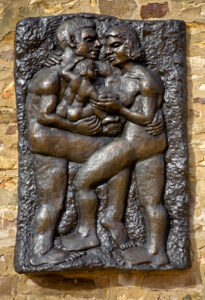
Selma H. Burke (1900-1995), Together, 1975/cast 2001. Bronze. 74 x 49 x 9 inches. James A Michener Art Museum. Museum purchase with assistance from John Horton, William Mandel, the Bjorn T. Polfelt memorial fund, Carolyn Calkins Smith and the friends of Selma Burke.
About the Artwork:
This is an example of a bronze relief sculpture by Selma Burke that you can find installed on the old prison wall in the Museum’s Pfundt Sculpture Garden. A relief sculpture is a type of sculpture that is found on a wall or made integral to a wall’s surface. You cannot walk around a relief sculpture like you can with other sculpture. Sculpture that can be viewed from multiple sides is called sculpture in the round.
Burke sculpted in clay, brass, stone and wood. She was committed to sculpture as an art form and she founded the Bucks County Sculpture Show, which promotes public appreciation for this ancient medium. She studied sculpture in Europe with Aristide Maillol and Henri Matisse who influenced her in her work. Burke is best known for winning a competition to design a bust of U.S. President Franklin Delano Roosevelt which appears on the dime.
Burke also believed in passing on what she learned as an artist to other people. She taught art in many different colleges and universities, along with founding two art schools, the Selma Burke School of Sculpture in New York City and the Selma Burke Art Center in Pittsburgh, Pennsylvania.
The Michener Art Museum commissioned the casting of the relief sculpture Together from the resin mold used to produce Selma Burke’s original 1975 bronze bas-relief, owned by Hill House Center in Pittsburgh, Pennsylvania. This work shows a man and a woman embracing a young child. This sculpture expresses one of Burke’s favorite themes, family love and unity. During the latter part of her career, when Together was created, Burke created many images centered around children and family life, saying in 1994, “I carved my family out of stone.”
Looking Questions:
- What do you see in this work? Describe or write down all the details you can find.
- Describe the various textures you can see in the work.
- What do you notice about the size of the work? Would this work have the same impact if it was smaller? Explain your answer.
- Describe the figures in this work. Who are they? How are they portrayed?
- One of Burke’s favorite themes to use in her artwork was family love and unity. How has she shown this in her artwork? What other symbols or images could represent this theme?
- Are there any personal connections can you make with Burke’s artwork? Explain your answer.
- How do you define family? If you could create a sculpture about your family, what would it look like? Describe it to a friend or family member.
Activities at Home:
- Draw Your Sculpture: If you could create a sculpture about your family, what would it look like? Would it be a relief sculpture or a sculpture in-the-round? Use pencil or colored pencils for your drawing.
- Poetry Activity: Write a list of 10 words to describe your family. (Think about: culture, heritage, traditions, values, personalities, etc.). Now, use the words that you have written about your family to create a poem of your choice. Or, combine the words to create a unique poem of your own. No rules apply!
- Adjective Activity: Write down 10 words that come to your mind in response to Burke’s sculpture. They can be words that describe the artwork or your feelings/reactions to it. Use these words in a poem of your choice.
Related Resources:
- Download an activity sheet about Together by Selma Burke.
- Explore some writing activities to do at home in response to this work.
- Look closer at this relief sculpture on Google Arts and Culture.
- For more information, visit Selma Burke on our online Bucks County Artists’ Database.
- Visit the The Metropolitan Museum of Art to read more about the history of relief sculpture in the United States.
- See other work by Selma Burke on Google Arts and Culture.